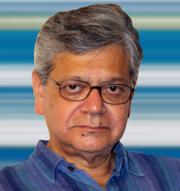
SUBIR ROY
AS medical science progresses and economic development leads to cleaner environments that transmit smaller infection loads, people are living longer lives. This is to be celebrated but the downside is that the quality of life often does not keep pace with the advancing years. The end of life is marked by fighting growing illnesses, in and out of hospitals. The question that arises is whether it is worth living all the additional years.
The usual response to this is, it is not in my hands when exactly my life will end; all I can do to hasten the end is by refusing treatment. But this is rather unscientific and increasingly people are asking themselves whether they can handle their last few years in an orderly manner and themselves decide when these will end.
The issue of euthanasia, ending a life through a conscious decision to do so, is increasingly coming to the fore. The least controversial is the doctors in attendance deciding that a patient is incurably ill and suffering much pain or, worse, has lost all powers to feel the pain and take a view on continuing such a life. In some societies the doctors in charge in such cases go in for euthanasia or medically assisted suicide to end the life of the patient. Euthanasia by disengaging the life support system on which a patient is surviving without the patient’s consent, is termed passive euthanasia.
What is more controversial is a patient seeking to go in for voluntary or active euthanasia, consciously asking the doctor to end their life by administering a lethal dose. This can be termed as assisted suicide and is frowned upon across the world. But a change is taking place in many societies, including in India, in that it is still frowned upon but is no longer being treated as a criminal offence for which one can be punished.
Right now only around 300 million people in a dozen countries including Switzerland (an early adopter), Australia, Netherlands, Belgium, Spain and Canada allow active euthanasia under medical guidance and that too under certain strictly defined conditions like the patient being afflicted by an incurable disease which causes much pain.
In India, passive euthanasia, the right to die, was allowed in 2018 as a fundamental right only in cases where a patient was brain dead and in a vegetative state, while active euthanasia remains illegal. In 2023, the Supreme Court modified the euthanasia guidelines to ease the process of allowing passive euthanasia for terminally ill patients.
The Bharatiya Nyaya Sanhita, which has replaced the Indian Penal Code, does not contain the provisions of Section 309 which punished an attempt to die by suicide. Over a lakh of people end their lives every year. The logic behind the change is the recognition that a person attempting suicide needs medical and psychiatric care and not punishment.
The euthanasia regime remains strict across countries because many believe that only God can take away life which only He can cause to come into being. There is also a fear of misuse, a patient’s life being ended without their permission to do so. Historically the most significant example of this occurred in Nazi Germany where thousands of adults and children with disabilities were euthanized.
Just as we plan our lives today from an early age, like which stream we will go into (arts or science), what kind of job we will look for, when to marry or whether to marry at all and when or whether to have children, it is critical to plan how we see the end of our lives play out. This will help families see their elders through the last part of their lives which is inevitably medicalised, protracted and painful.
Aviva Whittenberg-Cox, CEO of 20-first, a global consultancy, describes how her mother calmly and peacefully ended her life at age 97 in Canada when she had become wheelchair-bound, incontinent and dependent on care round the clock. What the family cherish the most is the serenity of a planned end at home, surrounded by family with ample time to express love and say goodbye.
As only 10 to 15 percent of us are lucky enough to drop dead, the rest spend their last days in physical and mental decline with medical knowledge and resources devoted to keeping them alive irrespective of the physical pain that it causes them and the mental anguish inflicted on the rest of the family.
The situation in India is that most do not take the trouble or have the foresight to plan how they will spend their last days. So it is often a painful end with serious disabilities and having to depend on care round the clock. The difference between developed countries where most people are covered by insurance or a national health service and a developing country like India is that here most cannot afford care which has to be paid out-of-pocket and so have to depend on the family to perform the most basic physical functions of living.
The urgent need today is for an advocacy movement in the country which advises people on how to plan the end of their lives and thus make it bearable when it comes. Such advocacy does not come easy and is often beset by public controversy. Over a decade ago, an attempt by the US administration to cover the uninsured became embroiled in political controversy. Sarah Palin, a presidential contender, used one provision of the proposed legislation to claim that the government was seeking to create a “death panel”. The administration denied this and eventually the legislation removed a provision which would have allowed physicians to provide voluntary counselling to Medicare patients about things like a ‘living will’, advance directives and end-of-life care options.
The advocacy movement that needs to be launched should focus above all else on advising people how to create a living will. While a will covers what should happen to what a person leaves behind after death, a living will outlines what a person desires done in the last stages of their life. It typically specifies the kind of medical care that an individual does or does not want in the event they are unable to communicate their wishes.
Doctors treating a person with terminal illness or life threatening injury will consult the living will to decide whether to withdraw the life support system or not. If there is no such will then close relatives have to advise the doctors what the patient wants from what they had earlier told them verbally. Ideally, a living will should clarify where a person stands vis-à-vis passive or voluntary euthanasia. The financial condition of the family would typically guide a patient’s preferences in this regard.
Overall, two issues stand out. One, does a person give foremost importance to the quality of life in order to decide how long they wish to live? Two, whether the cost of end-of-life medical treatment and care will be affordable for the family. This is classically captured in the following statement: She was cured of cancer but it ruined her family financially.
Subir Roy is a senior journalist based in Kolkata
Comments
-

Anita Patil-Deshmukh, MD, MPH, PhD, FAAP. - June 30, 2024, 11:44 a.m.
Thank you for writing on a very important subject. As a USA Trained Neonatologist, I a 75 years old female, strongly believe that I would wish to die when I am still intellectually and physically intact, NOT dependent on any outside help of any kind and am living a productive and happy life but have lived long enough. I should be allowed to chose my end in a happy state of affairs and not wait till I get sick and then thrown in the hospital. That's an awful place for anyone,to be in and to die. ( having worked in a NICU for 25 long years) We need to have a global situation where we are allowed to end our lives in happy state of minding body and chose the way to end life peacefully, without pain. That should be our RIGHT!!!!




